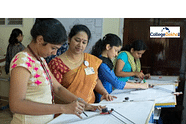KCET Current Electricity Topics 2025 include Introduction to Electric Current, Ohm’s Law, Resistivity of Various Materials, Electrical Energy and Power, Cells, Emf, Internal Resistance, Kirchhoff’s Rules, etc. Test takers can check the complete list of topics in this article.

KCET Current Electricity Topics Topics 2025:
KCET Current Electricity Topics constitute an important section of the KCET Second-Year PUC Physics Syllabus.KCET 2025Current Electricity Topics include Introduction to Electric Current, Ohm’s Law, Resistivity of Various Materials, Electrical Energy and Power, Cells, Emf, Internal Resistance, Kirchhoff’s Rules, Wheatstone Bridge, Numericals Etc. Candidates seeking admission through the KCET 2025 exam need to be familiar with the list of important topics under the KCET Current Electricity section. Preparing such topics in an efficient manner is an excellent approach which will help the candidates gain an advantage in the
KCET 2025 exam
. We have noted down all the key topics of KCET Current Electricity from the KCET 2025 syllabus. Candidates are advised to read the article thoroughly for detailed information related to the KCET Current Electricity Topics 2025.
Quick Links:
KCET Current Electricity Topics 2025
The topics covered under the KCET Current Electricity section have been discussed below.
KCET Physics Current Electricity Topics (2nd PUC)
Topics | Sub-Topics |
|---|---|
Introduction to Electric Current |
|
Ohm’s Law |
|
Resistivity of Various Materials |
|
Electrical Energy and Power |
|
Cells, Emf, Internal Resistance |
|
Kirchhoff’s Rules |
|
Wheatstone Bridge |
|
Numericals |
|
Current:
Current via a given area of a conductor is the net charge passing per unit time through the area.
Emf:
Emf refers to electromotive force which is the voltage difference between the two terminals of a source in an open circuit.
Ohm’s law:
The electric current I flowing through a substance is proportional to the voltage V across its ends, i.e.,
or V = RI.
where R is referred to the resistance of the substance.
The unit of resistance is ohm.
Resistance (R):
Resistance (R) of a conductor depends upon its length “l” and constant cross-sectional area “A” through the relation,
Where ρ, called resistivity, is a property of the material and depends on temperature and pressure.
Electrical resistivity:
The electrical resistivity of substances varies over a very wide range.
Metals have low resistivity, in the range of 10–8 Ω m to 10–6 Ω m.
Insulators such as glass and rubber have 1022 to 1024 time’s greater resistivity.
Semiconductors such as Si and Ge lie roughly in the middle range of resistivity on a logarithmic scale.
Current density:
Current density (j) gives the amount of charge flowing per second per unit area normal to the flow ,
where n is the number density (number per unit volume) of charge carriers each of charge q.
is the drift velocity of the charge carriers.
For electrons q = –e ,
if j is normal to a cross-sectional area A and is constant over the area, the magnitude of the current I through the area is,
Using E = V/l,
and Ohm’s law,
one obtains,
-
The proportionality between the force eE on the electrons in a metal due to the external field E and the drift velocity Vd (not acceleration) can be understood, if one assumes that the electrons suffer collisions with ions in the metal, which deflect them randomly. If such collisions occur on an average at a time interval
,
where a is the acceleration of the electron.
This gives ,
In the temperature range in which resistivity increases linearly with temperature, the temperature coefficient of resistivity α is defined as the fractional increase in resistivity per unit increase in temperature.
Ohm’s law is obeyed by many substances, but it is not a fundamental law of nature.
It fails if:
(a) V depends on I non-linearly.
(b) The relation between V and I depends on the sign of V for the same absolute value of V.
(c) The relation between V and I is non-unique.
- An example of (a) is when ρ increases with I (even if temperature is kept fixed). A rectifier combines features (a) and (b). GaAs shows the feature (c).
When a source of emf ε is connected to an external resistance R, the voltage Vext across R is given by,
where r is the internal resistance of the source.
(a) Total resistance R of n resistors connected in series is given by,
(b) Total resistance R of n resistors connected in parallel is provided by,
using which the value of one resistance can be determined, knowing the other three resistances.
The Potentiometer:
The potentiometer refers to a device to compare potential differences. Since the method involves a condition of no current flow, the device can be used to measure potential differences; and internal resistance of a cell and compare emf’s of two sources.
Quick Links:
Best Books to Prepare for KCET Physics 2025
Candidates appearing for the KCET 2025 exam should be aware of the best books available in the market for their preparations. With the help of KCET Best Books 2025, candidates can check important topics and chapters asked in the KCET exam previously. The best books for KCET Physics preparation have been tabulated below.
- Physics for Karnataka CET and COMEDK
- NCERT books of Class 11 and 12 for Physics
- Physics for Karnataka CET and COMEDK by K. L. Gomber and K. L. Gogia
- Physics for 1st Year PUC by AS Govind
- Fundamentals of Physics by S Chand
- Pradeep’s Fundamental Physics (Class 11 and 12)
KCET Physics Exam Pattern 2025
KCET Physics exam pattern 2025 has been tabulated below.
Particulars | Details |
|---|---|
Langage | English or Kannada |
Exam Mode | Pen and Paper-based Test |
Total number of questions | 60 MCQs |
Duration of paper | 1 Hour and 20 Minutes |
Marks for each question | 1 Mark for Every Correct Response |
Negative Marking | Not Applicable |
Related Articles:
We hope this article has been helpful for the candidates to be aware of the KCET Current Electricity Topics 2025. For more information related to the KCET 2025 exam, stay tuned to CollegeDekho! Candidates can also fill our
Common Application Form
in case of any queries related to the KCET 2025 exam.
Are you feeling lost and unsure about what career path to take after completing 12th standard?
Say goodbye to confusion and hello to a bright future!

FAQs
The cutoff of KCET refers to the minimum marks required by candidates to qualify for the KCET exam. KEA KCET cutoff is released separately for the general merit and Hyderabad Karnataka region. The exam authority releases the KCET cutoff after each counselling round.
It is not mandatory to attempt the Biology paper in the KCET exam if you want to opt for Engineering. Biology marks are only considered for the Medical, Dental and Paramedical fields. However, if you want to pursue Biotechnology in Engineering, attempting Biology in the KCET exam is compulsory.
50% mark is the passing percentage for the general category candidates and 40% for the SC/ST/OBC category for the KCET exam.
As per the previous year exam analysis, the KCET 2025 exam might be of a moderate to difficult level. KCET questions will be based on the first and second-year PUC syllabus as determined by the Department of Pre-University Education of Karnataka State.
Candidates looking to score good marks in the Karnataka CET exam are advised to solve the KCET previous year question papers and mock tests. Solving PYQs of KCET will enable candidates to get an idea about the KCET question paper pattern and the marking scheme.
NCERT best books are a good choice for candidates to start if they want to prepare for the KCET 2025 exam. Upon finishing the NCERT books, candidates can move ahead to the crucial KCET best books. Additionally, the KCET best books are another resource that candidates can use to study for the KCET exam.
The identical chapters and subjects from Classes 11 and 12 are covered by the questions in both KCET and JEE Main exams. However, in comparison to KCET, the questions in the JEE Main exam are more difficult.
In KCET Physics, chapters such as Gravitation, Motion in a Straight Line, Oscillations, and Thermodynamics each contribute approximately 7% to 8% of the exam paper.
No, candidates cannot skip Mathematics in the KCET exam. Mathematics is a compulsory subject in the KCET exam, and skipping it would disqualify candidates from the examination.
Chapters with maximum weightage in the Physics section of KCET are Gravitation, Motion in a Straight Line, Oscillations and Thermodynamics since these carry 7% to 8% weightage. Important chapters for KCET Mathematics include Integration, Vectors, Permutation and Combination, and 3-D Geometry. These topics weigh around 6% to 7% in the exam.
Was this article helpful?




















Similar Articles
Total B.Tech Seats in IITs vs JEE Advanced Qualifiers: Is there a need to Increase Seats in IITs?
KCET Semiconductor Electronics Weightage 2026
GUJCET vs Board Marks Weightage for Gujarat Engineering & Pharmacy Seats
What to do if you face payment issues while filling GUJCET 2026 application form?
JEE Mains 2026 Login (Open), Application Number and Password - Steps to Retrieve
AP ECET 2026: Exam Date, Syllabus, Eligibility, Exam Pattern